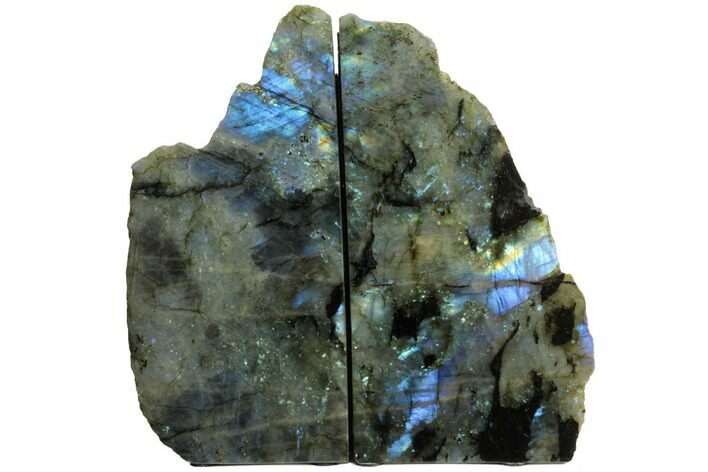This Specimen has been sold.
8.2" Polished, Flashy Labradorite Bookends - Madagascar
This is a flashy, labradorescent pair of labradorite bookends that were made in Madagascar. One side has been cut flat and polished to a glossy finish, while the opposite side has been left rough. The brilliant blue/green/gold colors have a lot of play in the light, giving the bookends an entirely different personality when viewed from different angles and lighting. The middle of the bookends have been lined with felt and the bottom has round rubber "feet" to prevent scratching of the display surface.
Each end varies slightly in size, with one measuring 8.2" tall, 4" wide and 2.2" thick while the other is 8" tall, 4.3" wide and 2.2" thick. Together these bookends weigh just over 7 lbs.
Each end varies slightly in size, with one measuring 8.2" tall, 4" wide and 2.2" thick while the other is 8" tall, 4.3" wide and 2.2" thick. Together these bookends weigh just over 7 lbs.
About Labradorite
Labradorite is a feldspar mineral most often found in mafic igneous rocks. Some specimens of labradorite exhibit what is called a "Schiller effect"; a strong play of iridescent blue, green, red, orange, and yellow colors. Labradorite is so well known for these spectacular displays of color that the phenomenon is also known as labradorescence. Specimens with high quality labradorescence are often polished and used as gemstones.
The labradorescence is not caused by the colors breflecting on the surface of the specimen. Instead, light enters the stone, hits a twinning crystal lattice surface within the stone, and reflects from that. The color seen is the color of light reflected from that twinning surface. Different twinning surfaces within the stone reflect different colors of light. Light reflecting from different twinning surfaces in various parts of the stone can give the stone a multi-colored appearance.
Labradorite is named after Labrador, Canada, where it was first found. Today, the most prolific deposits for most commercially available labradorite occur in Madagascar and Russia.
Labradorite is a feldspar mineral most often found in mafic igneous rocks. Some specimens of labradorite exhibit what is called a "Schiller effect"; a strong play of iridescent blue, green, red, orange, and yellow colors. Labradorite is so well known for these spectacular displays of color that the phenomenon is also known as labradorescence. Specimens with high quality labradorescence are often polished and used as gemstones.
The labradorescence is not caused by the colors breflecting on the surface of the specimen. Instead, light enters the stone, hits a twinning crystal lattice surface within the stone, and reflects from that. The color seen is the color of light reflected from that twinning surface. Different twinning surfaces within the stone reflect different colors of light. Light reflecting from different twinning surfaces in various parts of the stone can give the stone a multi-colored appearance.
Labradorite is named after Labrador, Canada, where it was first found. Today, the most prolific deposits for most commercially available labradorite occur in Madagascar and Russia.
SPECIES
Labradorite
LOCATION
Madagascar
SIZE
8.2 x 4", up to 2.2" thick
CATEGORY
ITEM
#129850
 Reviews
Reviews













